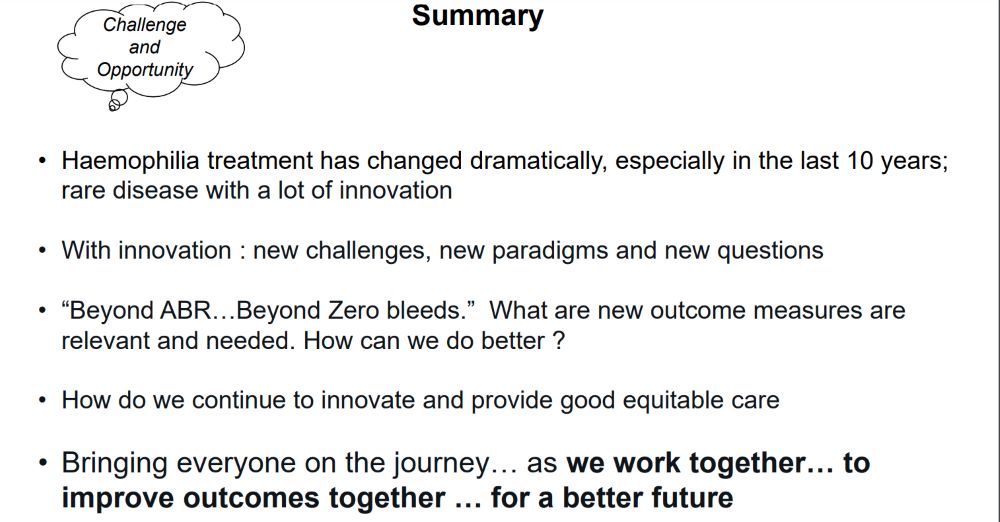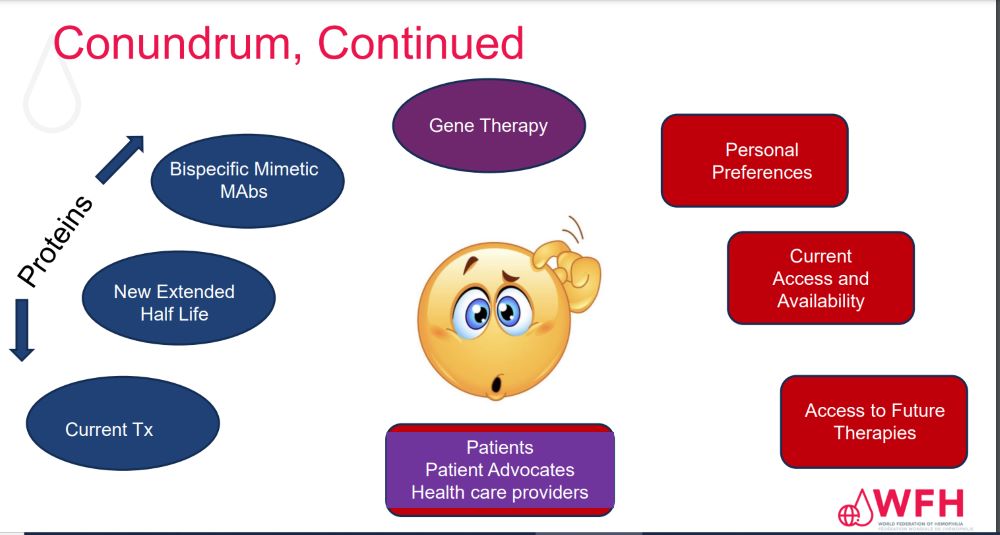ALEX KLEVER
Alex Klever is Clinical Nurse Consultant – Haemophilia at the Queensland Haemophilia Centre, Royal Brisbane & Women’s Hospital
Chair ~ David Fagan
From then to now ~ Gavin Finkelstein
What is precision or personalized medicine? New and emerging treatments for all bleeding disorders ~ Dr Glenn Pierce
Australian experience and challenges with new and emerging haemophilia therapies ~ Dr Liane Khoo
Access to new therapies – policy and regulation ~ Jo Cameron
Hopes for the future: reflections from a parent ~ Claire
It was such a pleasure to have Dr Glenn Pierce giving the opening plenary at the Conference. He spoke about personalized medicine and emerging treatments, touching on the progression of treatment options for people with haemophilia over the years.



Dr Pierce discussed patient-orientated algorithms for personalised treatment choices in the current treatment landscape, which led to the development of the WFH Shared Decision-Making Tool, now available at sdm.wfh.org. This tool enables patients and their families to work together with their healthcare professionals to make the best informed choice about their treatment options.
One issue highlighted by Dr Pierce was the ongoing health inequity for people with haemophilia in countries with limited resources and how this could be addressed by providing gene therapy. Even though currently this is a costly treatment, it has the potential to be ‘one shot and you’re done’ which may well be a more sustainable option in the long term for countries that have limited or no access to other haemophilia treatments.
Dr Liane Khoo then spoke about the Australian experience and challenges with new and emerging haemophilia therapies. She spoke about the whole team approach with patients and their families at the centre. The evolution of the treatments for haemophilia patients was very interesting and it was amazing to see how far we have come. What’s even more exciting is that Australia thus far has participated in 64 clinical trials!



Dr Khoo then walked through the newer therapies that are on the market now and what is coming soon and the challenges these bring to patients and clinicians. Needs of the patients will be changing as well as the needs of the Treatment Centres and their models of care. As a closing note she mentioned as we work together to improve outcomes together for a better future, which was a very appropriate statement for this year’s Conference.
NATALIE KARLOVIC
Natalie Karlovic is Physiotherapist – Oncology, Haemophilia and Palliative Care, Children’s Health, Queensland Hospital and Health Service
Chair ~ Prof Huyen Tran
Overview ~ Dr Glenn Pierce
Psychological overview ~ Jane Portnoy
Overview into AHCDO Gene therapy roadmap ~ Prof Huyen Tran
One of the hot topics at the Conference was Australia’s foray into gene therapy. Already a few Haemophilia Treatment Centres around Australia have supported clinical trials with gene therapy for their patients. Whilst these presentations were predominantly focused on the medical complexities and further implementation strategies for Australia, the early evidence is showing good results.
Dr Glenn Pierce, one of the pioneers in gene therapy and currently the World Federation of Hemophilia Vice President Medical, was among the speakers sharing emerging evidence gathered from other countries and how this is applicable to Australia.



Chair ~ Anne Jackson
The impact of new treatments on children and families ~ Anne Jackson
Impact on practice in the paediatric setting – a paediatric nurse’s view ~ Janine Furmedge
Physical activity in children ~ Nicola Hamilton
Young adult and his mother’s perspective ~ Catherine and Lachlan
While gene therapy is not currently available for patients under the age of 18 years, an insightful and valuable perspective was offered from a young adult patient and his family on the impact of extended half-life therapies. The change from daily prophylaxis dosing to less frequent infusions has had a large impact on their treatment burden and ultimately their quality of life.
The presentation from Nicola Hamilton, a physiotherapist from the Royal Children’s Hospital in Melbourne, highlighted the importance of the role of physiotherapy within this space – in particular, helping children with haemophilia to identify what a joint/muscle bleed appears like when on these new therapies. Her presentation also encompassed the importance of physical activity and limiting increased screen time within all children – not only children affected by haemophilia or other bleeding disorders.
Haemophilia Foundation Australia acknowledges the Traditional Owners and Custodians of Country throughout Australia, the land, waters and community where we walk, live, meet and work. We pay our respects to Elders past and present and extend that respect to all Aboriginal and Torres Strait Islander peoples.
Sign up for the latest news, events and our free National Haemophilia magazine